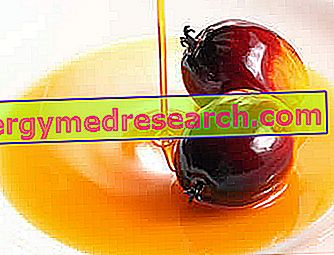Definition
Among the typical childhood diseases, Reye's syndrome plays a major role in terms of danger: we are talking about a serious pathological condition, potentially fatal, caused by the administration of acetylsalicylic acid in children under the age of 12 years.
Causes
Despite the precise cause responsible for the syndrome is still under investigation, it seems that Reye's syndrome is subject to the administration of acetylsalicylic acid to children under the age of 12, following flu, cold or chickenpox. The drug, in contact with the toxins of the virus, can enhance its therapeutic activity, creating damage.
- Possible further risk factors: fatty acid oxidation disorders, chronic exposure to herbicides, insecticides or other toxic substances
Symptoms
Reye's syndrome creates more damage to the liver and brain, leading to significant inflammation. Diarrhea and tachycardia are two constants in affected children under the age of 2 years; in larger ones, persistent vomiting and lethargy are more frequent. Among the other symptoms, we recall: hallucinations, mood alteration, mental confusion, weakness, hepatomegaly, hyperammonemia, hypoglycemia, irritability.
- Complications: coma, encephalopathy, death
Information on Reye's Syndrome - Drugs for the Treatment of Reye's Syndrome is not intended to replace the direct relationship between health professional and patient. Always consult your doctor and / or specialist before taking Reye's Syndrome - Drugs for the Treatment of Reye's Syndrome.
drugs
There is no specific drug capable of reversing the pathology during the advanced stage: from here, we understand how the promptness of intervention is indispensable to save the patient's life and to ensure its complete restoration. Since cerebral and hepatic inflammation is the two most severe symptoms, the primary objective is definitely to reduce inflammation.
As can be guessed, the smartest trick to prevent Reye's syndrome is simply to avoid giving this drug to children under the age of 12-16: for the treatment of flu and chickenpox, it is recommended to take it of paracetamol, an excellent substitute for acetylsalicylic acid in children.
The treatment of Reye's syndrome is purely symptomatic:
- Hypoglycemia is a constant in children with Reye's syndrome: therefore, it is recommended to intervene with an electrolytic therapy aimed at replenishing lost sugars and mineral salts. Most often, electrolyte integration therapy is performed in the hospital, by intravenous infusion: this medical practice is essential to provide the body with the essential nutrients it needs, in much faster times than by oral administration.
- Patients with Reye's syndrome are susceptible to bleeding: in this case, supplementation with vitamin K, plasma and platelets is recommended:
- Vitamin K (eg Vitamin K SALF): in general, the indicative dose for vitamin K deficiency suggests taking 2.5-5 mg of drug orally per day. Alternatively, administer the drug at a dose of 1-2 mg, intramuscularly, intravenously or subcutaneously. In some cases, a more important administration of phytonadione is necessary: the drug is also available in 10 mg and 50 mg vials, to be taken by IV or IM injection. Take 1 or two vials a day, depending on the severity of the condition.
- In the case of bacterial superinfections in the context of Reye's syndrome, it is recommended to take antibiotics, always after careful diagnostic assessment. The names of some medicinal products are listed below: it will be the duty of the physician to determine which drug is best suited to the patient, based on the pathogen responsible for the infection.
- Ciprofloxacin (eg. Ciproxin, Flontalexin, Ciprofloxac, Samper), quinolone derivative
- Lomefloxacin (eg Levofloxacin, Tavanic, Aranda, Fovex), quinolone derivative
- Sulfamethoxazole + trimethoprim (eg Bactrim), sulfonamide active
- Ceftriaxone (eg Ceftriaxone, Pantoxon, Ragex, Deixim), third-generation cephalosporin
- Erythromycin (eg Erythrocin, Erythro L, Lauromycin), macrolide drug
- The increase in intracranial pressure must be treated with diuretic drugs, able to favor the emission of liquids through urination
- Mannitol (eg Osmohale, Man10% BIN, Isotol): osmotic diuretic particularly indicated for the treatment of hypertension but also to reduce intracranial pressure in children with Reye's syndrome. The drug, by attracting water, decreases its reabsorption. The dosage must be carefully determined by the doctor, based on the severity of the condition. Mannitol and osmotic diuretics in general are the first choice drugs to reduce intracranial pressure in the context of Reye's syndrome.
- Hydrochlorothiazide (eg Rasitrio, Esidrex): this is a thiazide diuretic drug. As an indication, it is possible to administer a dose of 3mg / kg per day, orally in two equally divided doses, for children under the age of 6 months with Reye's syndrome. For children aged between 2 and 17 years, suffering from Reye's syndrome, it is possible to increase the dose up to 50 mg a day.
- Chronic exposure to toxic substances may, in some way, promote the onset of Reye's syndrome: in order to promote the elimination of the above harmful substances from the body, it is advisable to administer emollient laxatives .
- Liquid paraffin (eg Lacrilube, Paraf L BIN): paraffin is the forefather of emollient laxatives. The indicative dosage is 10-30 ml, when necessary.
- Peanut oil: formulated in the form of clisms, it lubricates and softens the intestinal content (compact), favoring intestinal motility.
- Glycerin (eg. Suppositories of Glycerine San Pellegrino): in the form of clisms, take 5.6 grams of drug by rectal route; alternatively, insert a 2-3 gram suppository as needed.
The only way to avoid Reye's syndrome is to NOT give salicylate drugs to children under the age of 12-16 (unless otherwise medically indicated).



